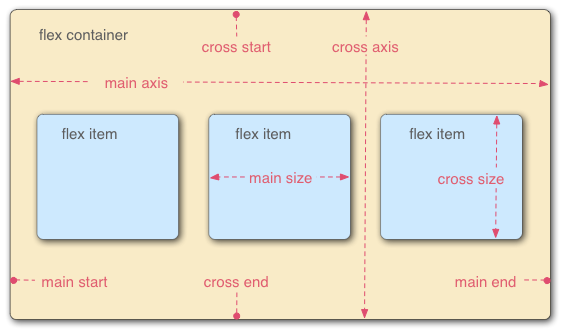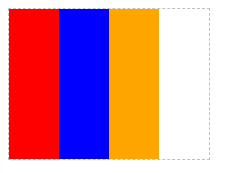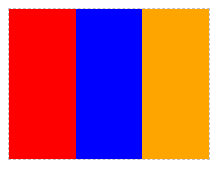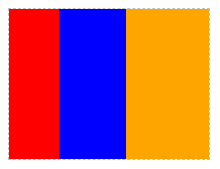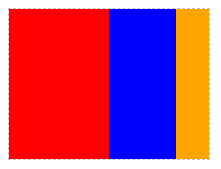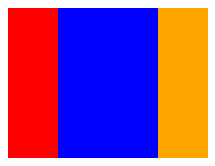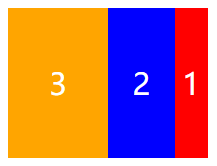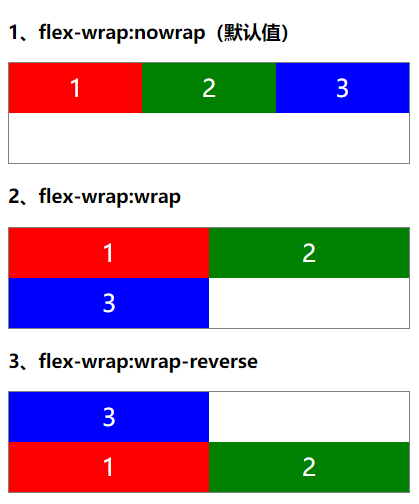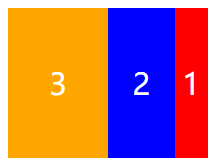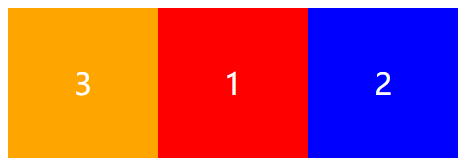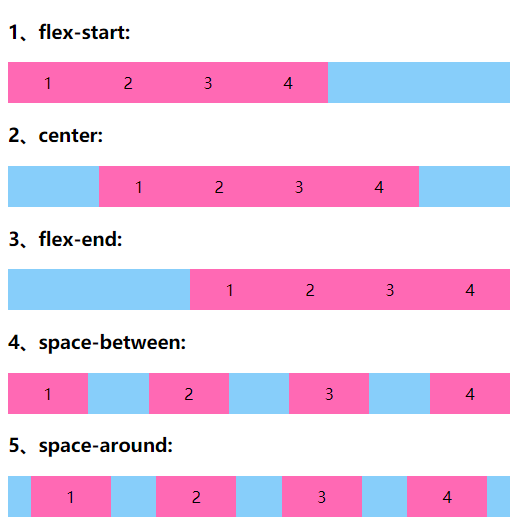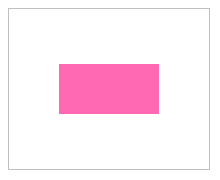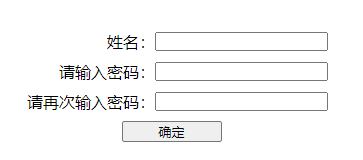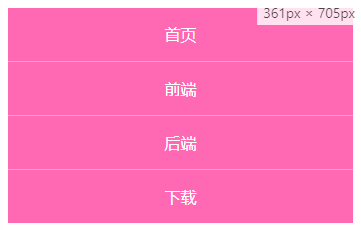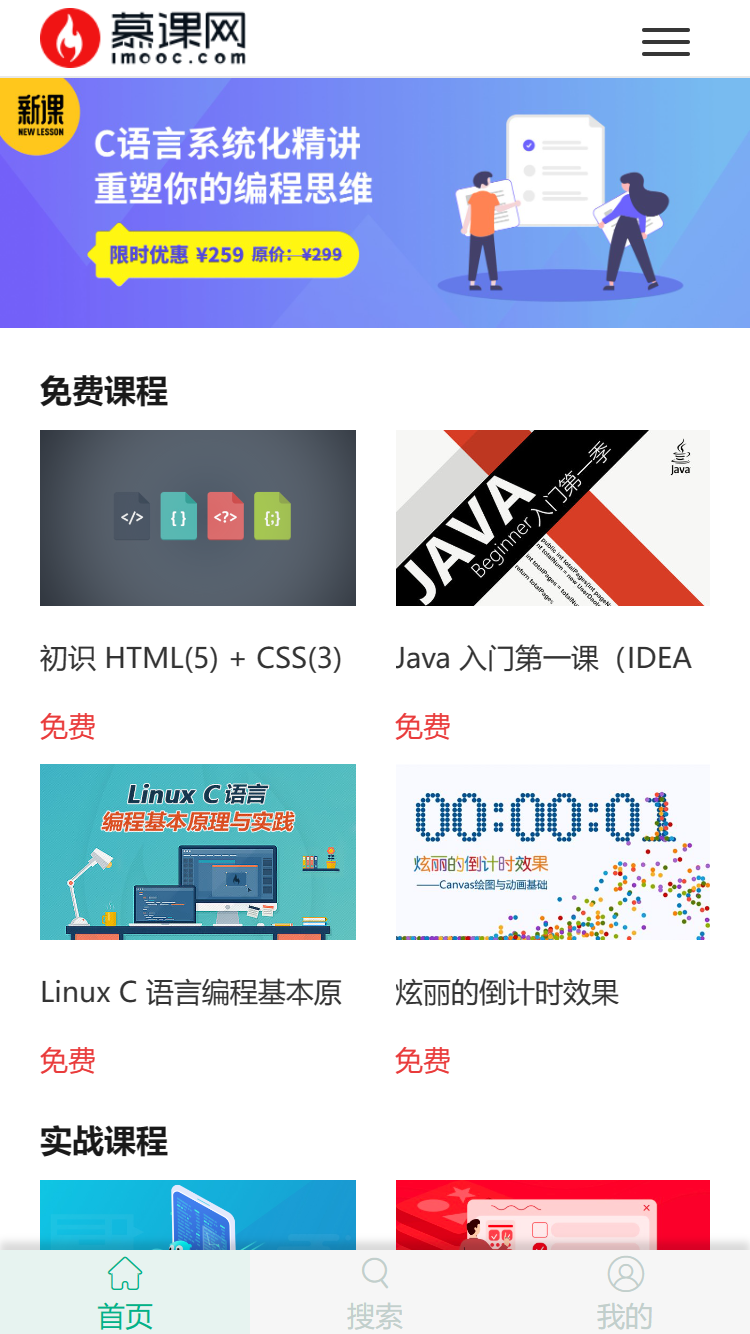文章目录
CSS3 flex弹性布局
概述
CSS3新增了一种新型的弹性盒子模型。通过弹性盒子模型,我们可以轻松地创建自适应浏览器窗口的“流动布局”以及自适应字体大小的弹性布局,使得响应式布局的实现更加容易。
此外记住一点:在使用弹性盒子模型之前,你必须为父元素定义display:flex;或display:inline-flex;,这样父元素才具有弹性盒子模型的特点。
flex属性
| 属性 | 说明 |
|---|---|
| flex-grow | 定义子元素的放大比例 |
| flex-shrink | 定义子元素的缩小比例 |
| flex-basis | 定义子元素的宽度,替代width属性 |
| flex | 复合属性,flex-grow、flex-shrink、flex-basis的简写 |
| flex-direction | 定义子元素的排列方向 |
| flex-wrap | 定义子元素是单行显示,还是多行显示 |
| flex-flow | 复合属性,flex-direction、flex-wrap |
| order | 定义子元素的排列顺序 |
| justify-content | 定义子元素在“主轴”上的对齐方式 |
| align-items | 定义子元素在“纵轴”上的对齐方式 |
使用
子元素宽度之和小于父元素宽度
<!DOCTYPE html>
<html>
<head>
<meta charset="utf-8" />
<title></title>
<style type="text/css">
#wrapper {
display: flex;
width: 200px;
height: 150px;
border: 1px dashed silver;
}
#box1,
#box2,
#box3 {
width: 50px;
}
#box1 {
background: red;
}
#box2 {
background: blue;
}
#box3 {
background: orange;
}
</style>
</head>
<body>
<div id="wrapper">
<div id="box1"></div>
<div id="box2"></div>
<div id="box3"></div>
</div>
</body>
</html>
子元素宽度之和大于父元素宽度
<!DOCTYPE html>
<html>
<head>
<meta charset="utf-8" />
<title></title>
<style type="text/css">
#wrapper {
display: flex;
width: 200px;
height: 150px;
border: 1px dashed silver;
}
#box1,
#box2,
#box3 {
width: 100px;
}
#box1 {
background: red;
}
#box2 {
background: blue;
}
#box3 {
background: orange;
}
</style>
</head>
<body>
<div id="wrapper">
<div id="box1"></div>
<div id="box2"></div>
<div id="box3"></div>
</div>
</body>
</html>
注:在这个例子中,弹性盒子(父元素)的宽度为200px,而所有子元素宽度之和为300px,此时子元素宽度之和大于父元素宽度。因此,子元素会按比例来划分宽度。这就是弹性盒子的特点。
flex-grow 放大比例
在CSS3中,我们可以使用flex-grow属性来定义弹性盒子内部子元素的放大比例。也就是当所有子元素宽度之和小于父元素的宽度时,子元素如何分配父元素的剩余空间。
默认值为 0,即不放大。当容器空间有剩余时,会按照各个项目设置的 flex-grow 值来分配剩余空间。如果一个项目的 flex-grow 设为 2,另一个项目设为 1,则前者占据的剩余空间是后者的两倍。
<!DOCTYPE html>
<html>
<head>
<meta charset="utf-8" />
<title></title>
<style type="text/css">
#wrapper {
display: flex;
width: 200px;
height: 150px;
border: 1px dashed silver;
}
#box1,
#box2,
#box3 {
width: 50px;
}
#box1 {
background: red;
flex-grow: 0;
}
#box2 {
background: blue;
flex-grow: 1;
}
#box3 {
background: orange;
flex-grow: 2;
}
</style>
</head>
<body>
<div id="wrapper">
<div id="box1"></div>
<div id="box2"></div>
<div id="box3"></div>
</div>
</body>
</html>
flex-shrink 缩小比例
在CSS3中,flex-shrink属性用于定义弹性盒子内部子元素的缩小比例。也就是当所有子元素宽度之和大于父元素的宽度时,子元素如何缩小自己的宽度。
默认值为 1,即缩小到最小值。当容器空间不足时,会按照各个项目设置的 flex-shrink 值来分配缺少的空间。与 flex-grow 对应的是,flex-shrink 数值越大的项目会被优先缩小。
<!DOCTYPE html>
<html>
<head>
<meta charset="utf-8" />
<title></title>
<style type="text/css">
#wrapper {
display: flex;
width: 200px;
height: 150px;
border: 1px dashed silver;
}
#box1,
#box2,
#box3 {
width: 100px;
}
#box1 {
background: red;
flex-shrink: 0;
}
#box2 {
background: blue;
flex-shrink: 1;
}
#box3 {
background: orange;
flex-shrink: 2;
}
</style>
</head>
<body>
<div id="wrapper">
<div id="box1"></div>
<div id="box2"></div>
<div id="box3"></div>
</div>
</body>
</html>
flex-basis 元素宽度
在CSS3中,我们可以定义弹性盒子内部的子元素在分配空间之前,该子元素所占的空间大小。浏览器会根据这个属性,计算父元素是否有多余空间。
说白了,flex-basis就是width的替代品,它们都用来定义子元素的宽度。只不过在弹性盒子中,flex-basis的语义会比width更好。
<!DOCTYPE html>
<html>
<head>
<meta charset="utf-8" />
<title></title>
<style type="text/css">
#wrapper {
display: flex;
width: 200px;
height: 150px;
border: 1px dashed silver;
}
#box1,
#box2,
#box3 {
flex-basis: 100px;
}
#box1 {
background: red;
flex-shrink: 0;
}
#box2 {
background: blue;
flex-shrink: 1;
}
#box3 {
background: orange;
flex-shrink: 2;
}
</style>
</head>
<body>
<div id="wrapper">
<div id="box1"></div>
<div id="box2"></div>
<div id="box3"></div>
</div>
</body>
</html>
flex 复合属性
flex属性的默认值为“0 1 auto”。
flex: 1;等价于flex: 1 1 auto
flex: 2等价于flex: 2 1 auto
<!DOCTYPE html>
<html>
<head>
<meta charset="utf-8" />
<title></title>
<style type="text/css">
#wrapper {
display: flex;
width: 200px;
height: 150px;
}
#box1 {
background: red;
flex: 1;
}
#box2 {
background: blue;
flex: 2;
}
#box3 {
background: orange;
flex: 1;
}
</style>
</head>
<body>
<div id="wrapper">
<div id="box1"></div>
<div id="box2"></div>
<div id="box3"></div>
</div>
</body>
</html>
flex-direction 排列方向
在CSS3中,我们可以使用flex-direction属性来定义弹性盒子内部“子元素”的排列方向。也就是定义子元素是横着排,还是竖着排。
flex-direction属性取值
| 属性值 | 说明 |
|---|---|
| row | 默认值,横向排列 |
| row-reverse | 横向反向排列 |
| column | 纵向排列 |
| column-reverse | 纵向反向排列 |
<!DOCTYPE html>
<html>
<head>
<meta charset="utf-8" />
<title></title>
<style type="text/css">
#wrapper {
display: flex;
flex-direction: row-reverse;
width: 200px;
height: 150px;
}
#box1,
#box2,
#box3 {
height: 150px;
line-height: 150px;
text-align: center;
font-size: 30px;
color: white;
}
#box1 {
background: red;
flex: 1;
}
#box2 {
background: blue;
flex: 2;
}
#box3 {
background: orange;
flex: 3;
}
</style>
</head>
<body>
<div id="wrapper">
<div id="box1">1</div>
<div id="box2">2</div>
<div id="box3">3</div>
</div>
</body>
</html>
flex-wrap 换行
在CSS3中,我们可以使用flex-wrap属性来定义弹性盒子内部“子元素”是单行显示还是多行显示。
flex-wrap属性取值
| 属性值 | 说明 |
|---|---|
| nowrap | 默认值,单行显示 |
| wrap | 多行显示 |
| wrap-reverse | 多行显示,但是是反向 |
<!DOCTYPE html>
<html>
<head>
<meta charset="utf-8" />
<title></title>
<style type="text/css">
/* 公用样式 */
.wrapper1,
.wrapper2,
.wrapper3 {
display: flex;
color: white;
font-size: 24px;
width: 400px;
height: 100px;
line-height: 50px;
border: 1px solid gray;
text-align: center;
}
.wrapper1 div,
.wrapper2 div,
.wrapper3 div {
height: 50%;
width: 50%;
}
.red {
background: red;
}
.green {
background: green;
}
.blue {
background: blue;
}
/* 弹性盒子样式 */
.wrapper1 {
flex-wrap: nowrap;
}
.wrapper2 {
flex-wrap: wrap;
}
.wrapper3 {
flex-wrap: wrap-reverse;
}
</style>
</head>
<body>
<h3>1、flex-wrap:nowrap(默认值)</h3>
<div class="wrapper1">
<div class="red">1</div>
<div class="green">2</div>
<div class="blue">3</div>
</div>
<h3>2、flex-wrap:wrap</h3>
<div class="wrapper2">
<div class="red">1</div>
<div class="green">2</div>
<div class="blue">3</div>
</div>
<h3>3、flex-wrap:wrap-reverse</h3>
<div class="wrapper3">
<div class="red">1</div>
<div class="green">2</div>
<div class="blue">3</div>
</div>
</body>
</html>
flex-flow 复合属性
在CSS3中,我们可以使用flex-flow属性来同时设置flex-direction、flex-wrap这两个属性。说白了,flex-flow属性就是一个简写形式,就是一个“语法糖”。
<!DOCTYPE html>
<html>
<head>
<meta charset="utf-8" />
<title></title>
<style type="text/css">
#wrapper {
display: flex;
flex-flow: row-reverse nowrap;
width: 200px;
height: 150px;
}
#box1,
#box2,
#box3 {
height: 150px;
line-height: 150px;
text-align: center;
font-size: 30px;
color: white;
}
#box1 {
background: red;
flex: 1;
}
#box2 {
background: blue;
flex: 2;
}
#box3 {
background: orange;
flex: 3;
}
</style>
</head>
<body>
<div id="wrapper">
<div id="box1">1</div>
<div id="box2">2</div>
<div id="box3">3</div>
</div>
</body>
</html>
order 排列顺序
在CSS3中,我们可以使用order属性来定义弹性盒子内部“子元素”的排列顺序。
<!DOCTYPE html>
<html>
<head>
<meta charset="utf-8" />
<title></title>
<style type="text/css">
#wrapper {
display: flex;
}
#box1,
#box2,
#box3 {
width: 150px;
height: 150px;
line-height: 150px;
text-align: center;
font-size: 30px;
color: white;
}
#box1 {
background: red;
order: 2;
}
#box2 {
background: blue;
order: 3;
}
#box3 {
background: orange;
order: 1;
}
</style>
</head>
<body>
<div id="wrapper">
<div id="box1">1</div>
<div id="box2">2</div>
<div id="box3">3</div>
</div>
</body>
</html>
justify-content 水平对齐
在CSS3中,我们可以使用justify-content属性来定义弹性盒子内部子元素在“横轴”上的对齐方式。
justify-content属性取值
| 属性值 | 说明 |
|---|---|
| flex-start | 默认值,所有子元素在左边 |
| center | 所有子元素在中间 |
| flex-end | 所有子元素在右边 |
| space-between | 所有子元素平均分布 |
| space-around | 所有子元素平局分布,两边留有间距 |
<!DOCTYPE html>
<html>
<head>
<meta charset="utf-8" />
<title></title>
<style type="text/css">
/*定义整体样式*/
.flex {
display: flex;
flex-flow: row nowrap;
background-color: lightskyblue;
margin-bottom: 5px;
}
.item {
width: 80px;
padding: 10px;
text-align: center;
background-color: hotpink;
box-sizing: border-box;
}
/*定义justify-content*/
.start {
justify-content: flex-start;
}
.center {
justify-content: center;
}
.end {
justify-content: flex-end;
}
.between {
justify-content: space-between;
}
.around {
justify-content: space-around;
}
</style>
</head>
<body>
<h3>1、flex-start:</h3>
<div class="flex start">
<div class="item">1</div>
<div class="item">2</div>
<div class="item">3</div>
<div class="item">4</div>
</div>
<h3>2、center:</h3>
<div class="flex center">
<div class="item">1</div>
<div class="item">2</div>
<div class="item">3</div>
<div class="item">4</div>
</div>
<h3>3、flex-end:</h3>
<div class="flex end">
<div class="item">1</div>
<div class="item">2</div>
<div class="item">3</div>
<div class="item">4</div>
</div>
<h3>4、space-between:</h3>
<div class="flex between">
<div class="item">1</div>
<div class="item">2</div>
<div class="item">3</div>
<div class="item">4</div>
</div>
<h3>5、space-around:</h3>
<div class="flex around">
<div class="item">1</div>
<div class="item">2</div>
<div class="item">3</div>
<div class="item">4</div>
</div>
</body>
</html>
align-items 垂直对齐
在CSS3中,我们可以使用align-items属性来定义弹性盒子内部子元素在“纵轴”上的对齐方式。
align-items属性取值
| 属性值 | 说明 |
|---|---|
| flex-start | 默认值,所有子元素在上边 |
| center | 所有子元素在中间 |
| flex-end | 所有子元素在下边 |
| baseline | 所以子元素在父元素的基线上 |
| stretch | 拉伸子元素适应父元素的高度 |
<!DOCTYPE html>
<html>
<head>
<meta charset="utf-8" />
<title></title>
<style type="text/css">
.box {
/*去除默认样式*/
list-style-type: none;
margin: 0;
padding: 0;
/*定义flex布局*/
display: flex;
width: 250px;
height: 150px;
border: 1px solid gray;
font-size: 24px;
}
h3 {
margin-bottom: 3px;
}
/*定义子元素样式*/
.box li {
margin: 5px;
background-color: lightskyblue;
text-align: center;
}
.box li:nth-child(1) {
padding: 10px;
}
.box li:nth-child(2) {
padding: 15px 10px;
}
.box li:nth-child(3) {
padding: 20px 10px;
}
/*定义align-items*/
#box1 {
align-items: flex-start;
}
#box2 {
align-items: center;
}
#box3 {
align-items: flex-end;
}
#box4 {
align-items: baseline;
}
#box5 {
align-items: stretch;
}
</style>
</head>
<body>
<h3>1、align-items:flex-start</h3>
<ul id="box1" class="box">
<li>a</li>
<li>b</li>
<li>c</li>
</ul>
<h3>2、align-items:center</h3>
<ul id="box2" class="box">
<li>a</li>
<li>b</li>
<li>c</li>
</ul>
<h3>3、align-items:flex-end</h3>
<ul id="box3" class="box">
<li>a</li>
<li>b</li>
<li>c</li>
</ul>
<h3>4、align-items:baseline</h3>
<ul id="box4" class="box">
<li>a</li>
<li>b</li>
<li>c</li>
</ul>
<h3>5、align-items:stretch</h3>
<ul id="box5" class="box">
<li>a</li>
<li>b</li>
<li>c</li>
</ul>
</body>
</html>
案例
水平和垂直居中效果
<!DOCTYPE html>
<html>
<head>
<meta charset="utf-8" />
<title></title>
<style type="text/css">
#container {
display: flex;
justify-content: center;
align-items: center;
width: 200px;
height: 160px;
border: 1px solid silver;
}
#box {
width: 100px;
height: 50px;
background-color: hotpink;
}
</style>
</head>
<body>
<div id="container">
<div id="box"></div>
</div>
</body>
</html>
输入框布局
<!doctype html>
<html>
<head>
<meta charset="utf-8">
<title>输入框布局</title>
<style>
* {
margin: 0;
padding: 0;
}
.container {
width: 300px;
height: 50px;
margin: 100px auto;
border: 1px solid #dcdcdc;
display: flex;
}
.container label {
flex: 1;
background-color: #f5f5f5;
font-family: "楷体";
display: flex;
justify-content: center;
align-items: center;
}
.container label:nth-child(3) {
flex: 0 0 60px;
}
.container input {
width: 170px;
border: none;
outline: none;
}
</style>
</head>
<body>
<div class="container">
<label>姓名</label><input type="text"><label>go</label>
</div>
</body>
</html>
长表单布局
<!DOCTYPE html>
<html>
<head>
<meta charset="utf-8">
<title>长表单布局</title>
<style type="text/css">
* {
margin: 0;
padding: 0;
}
.container {
margin: 100px;
display: flex;
flex-direction: column;
}
.container div {
display: flex;
align-items: flex-start;
flex: 0 0 30px;
justify-content: center;
align-items: center;
}
.container div label {
flex: 0 0 140px;
text-align: right;
}
.container div input[type="button"] {
width: 100px;
}
</style>
</head>
<body>
<form>
<div class="container">
<div>
<label>姓名:</label>
<input type="text">
</div>
<div>
<label>请输入密码:</label>
<input type="text">
</div>
<div>
<label>请再次输入密码:</label>
<input type="text">
</div>
<div>
<input type="button" value="确定">
</div>
</div>
</form>
</body>
</html>
导航栏
<!DOCTYPE html>
<html>
<head>
<meta charset="utf-8" />
<title></title>
<style type="text/css">
* {
margin: 0;
padding: 0;
}
ul {
list-style: none;
}
a {
text-decoration: none;
}
.nav {
width: 1210px;
height: 48px;
line-height: 48px;
background-color: #E8E7E3;
margin: 50px auto;
display: flex;
}
.nav li {
flex: 1;
}
.nav a {
display: block;
color: #808080;
text-decoration: none;
font-size: 16px;
text-align: center;
}
.nav a:hover {
background-color: #636363;
color: #fff;
}
</style>
</head>
<body>
<ul class="nav">
<li><a href="#">HTML/CSS</a></li>
<li><a href="#">Browser Side</a></li>
<li><a href="#">Server Side</a></li>
<li><a href="#">Programming</a></li>
<li><a href="#">XML</a></li>
<li><a href="#">Web Building</a></li>
<li><a href="#">Reference</a></li>
</ul>
</body>
</html>
伸缩菜单
<!DOCTYPE html>
<html>
<head>
<meta charset="utf-8" />
<title></title>
<style type="text/css">
/*定义整体样式*/
.nav {
/*去除默认样式*/
list-style-type: none;
margin: 0;
padding: 0;
/*定义弹性盒子*/
display: flex;
background-color: hotpink;
}
.nav a {
/*去除默认样式*/
text-decoration: none;
display: block;
padding: 16px;
color: white;
text-align: center;
}
.nav a:hover {
background-color: lightskyblue;
}
/*设备大于800px时*/
@media (min-width:800px) {
/*所有子元素在右边*/
.nav {
justify-content: flex-end;
}
li {
border-left: 1px solid silver;
}
}
/*设备大于600px且小于800px时*/
@media (min-width:600px) and (max-width:800px) {
/*所有子元素平分*/
.nav li {
flex: 1;
}
li+li {
border-left: 1px solid silver;
}
}
/*设备小于600px时*/
@media (max-width: 600px) {
/*所有子元素纵向排列*/
.nav {
flex-flow: column wrap;
}
li+li {
border-top: 1px solid silver;
}
}
</style>
</head>
<body>
<ul class="nav">
<li><a href="#">首页</a></li>
<li><a href="#">前端</a></li>
<li><a href="#">后端</a></li>
<li><a href="#">下载</a></li>
</ul>
</body>
</html>
